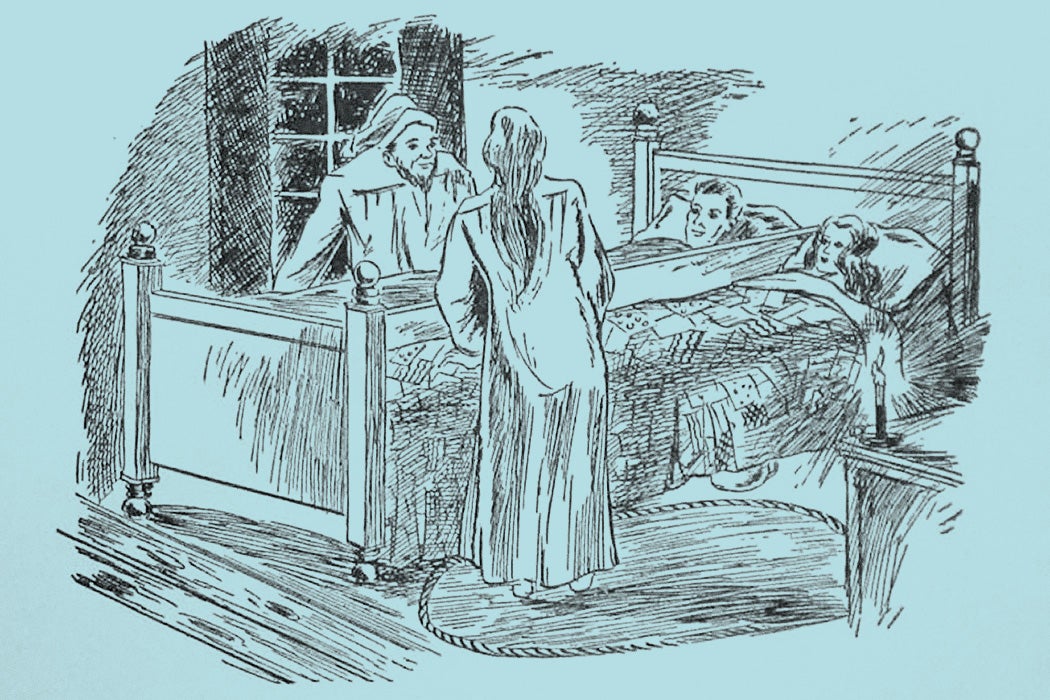Puritan-era New England conjures up images of scarlet letters, “sadd-colored” jackets buttoned to the neck, and dour, tight-lipped ancestors with names like Humiliation and Abstinence. Not exactly the most fertile ground for young love to bloom—or so you’d think. Some of the things young people in colonial North America were up to might have made their Victorian descendants faint dead away.
A common (if controversial) dating practice was “bundling,” in which a suitor could spend the whole night in bed with his sweetheart—fully clothed or separated by a “bundling board”—while her parents snoozed away in the next room.
“Their courtships commenc[ed] where ours usually finish,” Washington Irving wrote in 1809.
In theory, it was all quite innocent. As Reverend Samuel Peters explained in 1781, “I am no advocate for temptation; yet must say, that bundling has prevailed 160 years in New England, and, I verily believe, with ten times more chastity than the sitting on a sofa.”
Still, bundling didn’t always remain perfectly chaste, as a popular song of the era suggests:
Some maidens say, if through the nation,
Bundling should quite go out of fashion,
Courtship would lose its sweets; and they
Could have no fun till wedding day […]
A bundling couple went to bed,
With all their clothes from foot to head,
That the defence might seem complete,
Each one was wrapped in a sheet.
But O! this bundling’s such a witch,
The man of her did catch the itch,
And so provoked was the wretch,
That she of him a bastard catch’d.
As historian Richard Godbeer explains, both religious doctrine and law expected that couples should abstain from sex until after the marriage ceremony. But institutional prohibitions didn’t necessarily coincide with social behaviors. Plenty of people “believed that sex became morally and socially acceptable once a couple committed to each other,” he writes. Those who didn’t wait for marriage weren’t viewed as “rejecting morality so much as following a time-honored popular moral code that distinguished between premarital and casual sex.”
In fact, according to Godbeer, some 30–40 percent of brides in New England were pregnant when they walked down the aisle. Bundling, he argues, was actually a rather conservative practice. It allowed parents to keep track of their daughter’s suitors; if she did happen to get pregnant, there’d be ample witnesses to their courtship, making it easier to put pressure on the relevant parties to get married.
In this vein, Washington Irving argued—tongue in cheek—that bundling could be considered largely responsible for the early population boom in colonial New England,
for it is a certain fact, well authenticated by court records and parish registers, that wherever the practice of bundling prevailed, there was an amazing number of sturdy brats annually born unto the state, without the license of the law, or the benefit of clergy.
But bundling was hardly a Yankee innovation. It might have been brought to the continent by settlers from a number of different parts of Europe, where similar traditions flourished under a variety of names, writes Yochi Fischer-Yinon. It was “kweesten” in the Netherlands, “houlyenka” in Ukraine, “kiltgang” in the Alps, “nattfrieri” in Sweden, and so on, each variation having its own particular traditions.
Weekly Newsletter
Nattfrieri, for instance, was quite complex, write Marco H. D. van Leeuwen and Ineke Maas. A fraternity of men under the age of thirty, in which each paid a small membership fee (for the purpose of buying beer), organized courting visits. They gathered on Saturday nights and walked through the village, each man stopping to call at the house of the young woman of his choosing. To some extent, the purpose of these organizations seems to have been to prevent men from other villages from encroaching on what the boys saw as their “territory”—if a young man tried to court a girl from another parish, the whole group could gang up on him and force him to back off or to pay a fine.
Kiltgang, on the other hand, had a literary bent; a young man might stand under the window of the woman he’s wooing and beg admission through a ritualized exchange of poetry, writes E. M. Loeb. The girl would toss off a two-line proverb about nature; the boy responded with a proverb that revealed his emotions:
The thistle and the thorn no matter how they stick,
A false tongue penetrates still further.
No fire on earth burns so hot
As secret love which no one knows about.The flower fades
In field and in woods,
But the bloom in my heart
Ne’er fades nor grows old.
The bundling youth of New England, then, weren’t up to anything particularly new or unusual. They were simply remaking an old tradition on new ground.
Support JSTOR Daily! Join our membership program on Patreon today.







